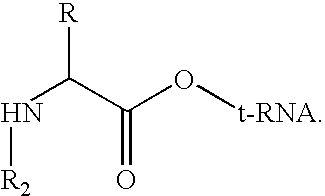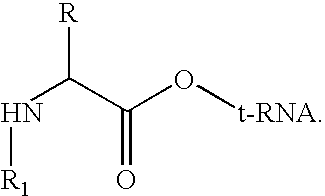Method for producing diverse libraries of encoded polymers
a polymer and library technology, applied in the field of diverse library production of encoded polymers, can solve the problems of limiting library complexity by the amount of non, affecting the stability or permeability of the library, and being susceptible to biodegradation of proteins, etc., to achieve the effect of improving stability or permeability, increasing the number of proteins, and facilitating the production of proteins
- Summary
- Abstract
- Description
- Claims
- Application Information
AI Technical Summary
Benefits of technology
Problems solved by technology
Method used
Image
Examples
example 1
Synthesis of Me-N-tRNAs by on tRNA Transformation
Preparation of S1 00 Extract
[0103] Twenty grams of E. coli cells were lysed and the cellular debris removed as described in Merryman, et al., Chem. & Biol. 9:741-746 (2002). Ribosomes were removed from the clarified cell lysate by centrifugation for 4 hours, at 4° C., at 40,000 rpm in a Beckman Ti60 rotor and the supernatant was diluted two fold with buffer D (10 mM Tris-HCl pH 7.5; 30 mM NH4Cl; 10 mM MgCl2; and 6 mM 2-mercaptoethanol (BME)). This solution was stirred with 12 g of dry DEAE-cellulose that was equilibrated with buffer D, washed with distilled water, and then dried. The slurry was filtered on a scintered glass funnel and washed with 1-2 liters of buffer D. The DEAE-cellulose cake was resuspended in buffer D and packed in a column. The S100 extract was then eluted with buffer D containing 250 mM NH4Cl (the desired fractions elute as a sharp band and can usually be identified by eye as they have a pale yellow color). Sm...
example 2
Use of Me-N-tRNAs in Generating Encoded Non-Standard Polymer Libraries
[0106] An in vitro translation mixture is combined with a complex pool of mRNA sequences, and an appropriate amount of bifunctional tRNA for making fusions Merryman, et al., Chem. & Biol. 9:741-746 (2002); Merryman and Bartel, U.S. Pat. No. 6,440,695). The translation mixture contains all of the factors required for in vitro translation (e.g., initiation factors, transformed tRNA analogues, and elongation factors) except for mRNA. Translation mixtures can be made by a number of standard methods. Translation is initiated by the addition of the complex pool of mRNA sequences. All of the members of the pool of mRNA sequences have a constant sequence at their 5′ end that permits them to be translated by the ribosome, an internal, randomized, polymer-coding segment and a UUU- and UUC-rich 3′ coding segment that recruits a bifunctional tRNA after translation of the randomized segment is completed. Each codon in the mRN...
example 3
Transformation of Aminoacyl tRNAs for the In Vitro Selection of “Drug-Like” Molecules
Materials and Methods
[0107] Ribosomes, S150 enzyme fraction, aminoacyl-tRNAs, in vitro protein synthesis reactions and mRNAs were made and used as previously described (Merryman, C., et al., Chem. &Biol. 9:741-746 (2002)). Individual tRNA species were purchased from Subriden (Rolling Bay, Wash.) or Sigma (St. Louis, Mo.). Radiolabeled amino acids, amino acid mixtures, and formaldehyde were obtained from Moravek Biochemicals (Brea, Calif.), American Radiolabeled Chemicals (St. Louis, Mo.) or Sigma. Other materials were purchased from standard sources.
Transformation of Puromycin
[0108] N-methyl puromycin was synthesized by incubating 8 mM puromycin, 50 mM o-nitrobenzaldehyde, and 20 mM cyanoborohydride in buffer (100 mM NaOAc pH 5.0; 37° C.). After 30 min, 0.2 volumes of 100 mM formaldehyde was added to the reaction and the incubation continued (ambient; 30 min). The sparingly soluble nitrobenzal...
PUM
 Login to View More
Login to View More Abstract
Description
Claims
Application Information
 Login to View More
Login to View More - R&D
- Intellectual Property
- Life Sciences
- Materials
- Tech Scout
- Unparalleled Data Quality
- Higher Quality Content
- 60% Fewer Hallucinations
Browse by: Latest US Patents, China's latest patents, Technical Efficacy Thesaurus, Application Domain, Technology Topic, Popular Technical Reports.
© 2025 PatSnap. All rights reserved.Legal|Privacy policy|Modern Slavery Act Transparency Statement|Sitemap|About US| Contact US: help@patsnap.com



